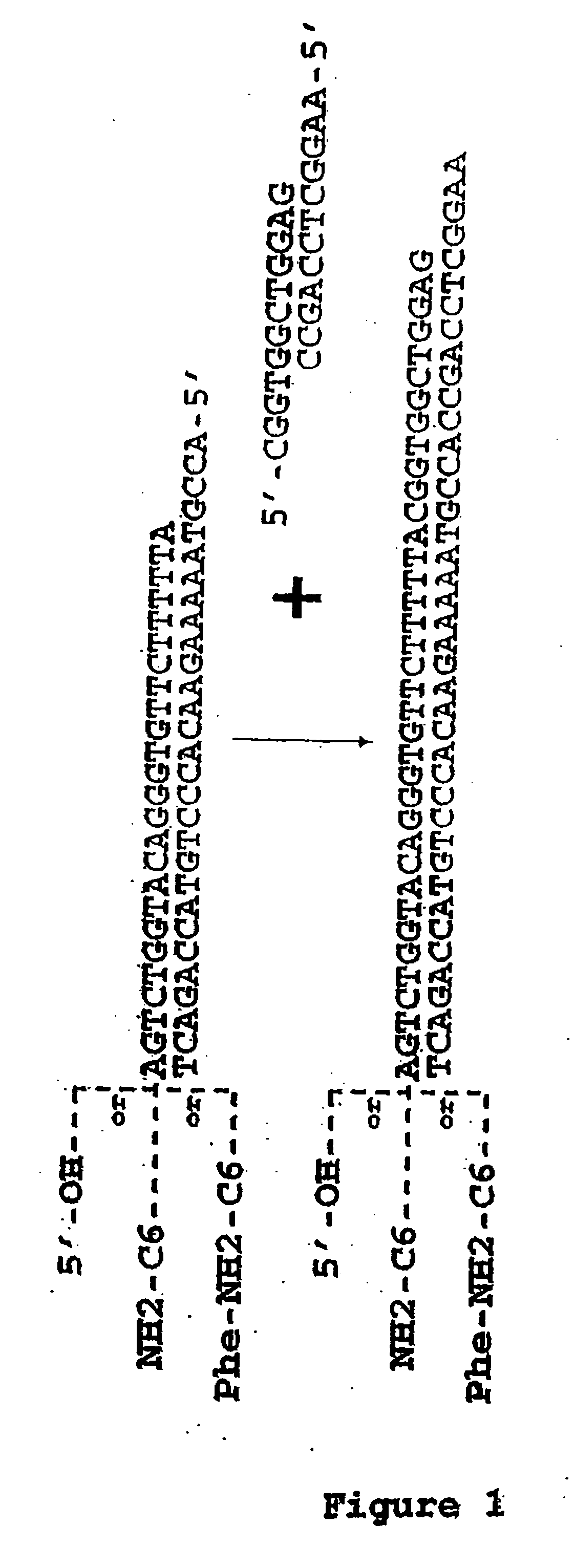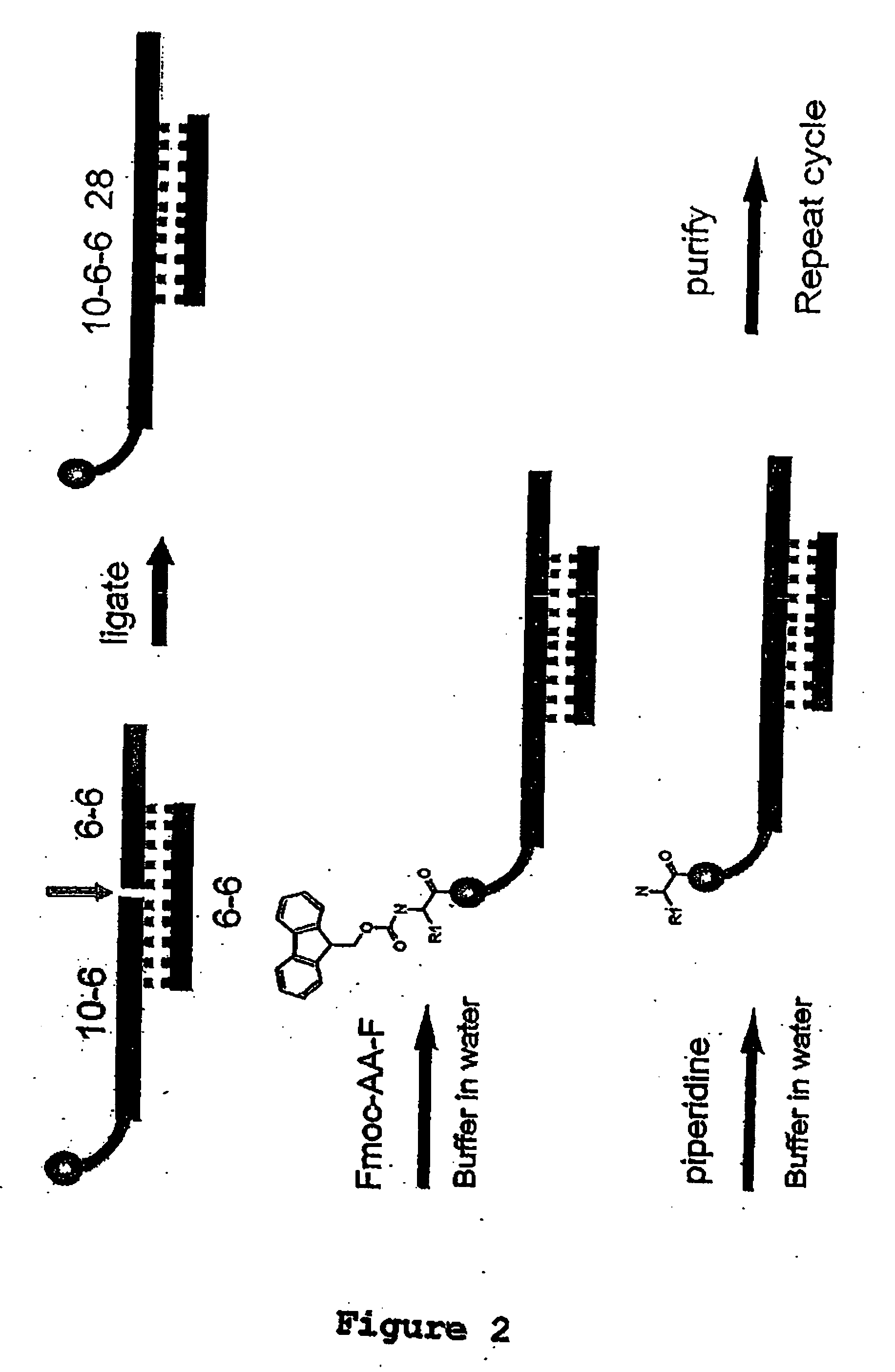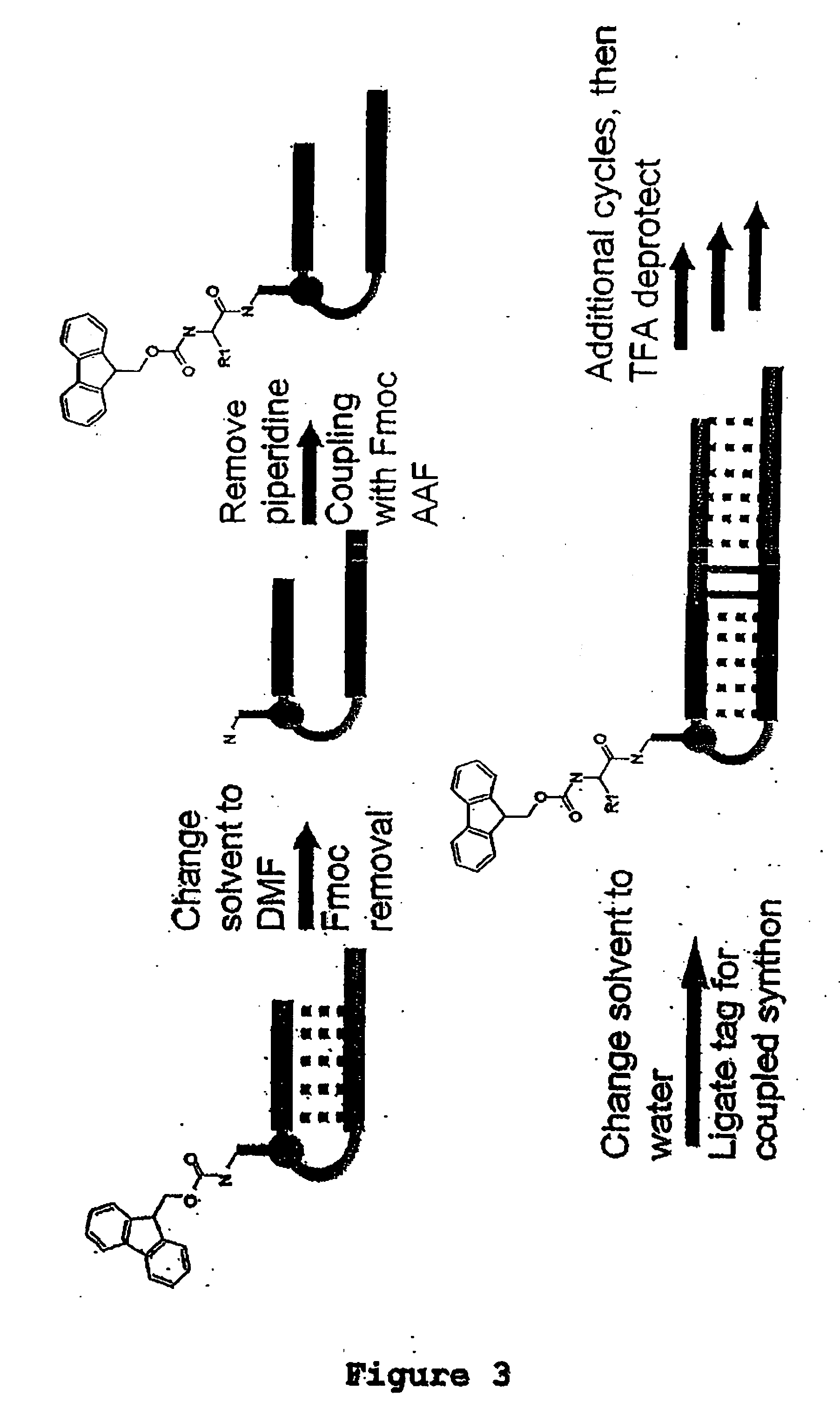Methods for synthesis of encoded libraries
- Summary
- Abstract
- Description
- Claims
- Application Information
AI Technical Summary
Benefits of technology
Problems solved by technology
Method used
Image
Examples
example 1
Synthesis and Characterization of a Library on the Order of 105 Members
[0154] The synthesis of a library comprising on the order of 105 distinct members was accomplished using the following reagents:
Compound 1:
Single Letter Codes for Deoxyribonucleotides:
C=cytidine
Building Block Precursors:
[0155] Oligonucleotide Tags:
SequenceTag number5′-PO4-GCAACGAAG(SEQ ID NO:1)1.1ACCGTTGCT-PO3-5′(SEQ ID NO:2)5′-PO3-GCGTACAAG(SEQ ID NO:3)1.2ACCGCATGT-PO3-5′(SEQ ID NO:4)5′-PO3-GCTCTGTAG(SEQ ID NO:5)1.3ACCGAGACA-PO3-5′(SEQ ID NO:6)5′-PO3-GTGCCATAG(SEQ ID NO:7)1.4ACCACGGTA-PO3-5′(SEQ ID NO:8)5′-PO3-GTTGACCAG(SEQ ID NO:9)1.5ACCAACTGG-PO3-5′(SEQ ID NO:10)5′-PO3-CGACTTGAC(SEQ ID NO:11)1.6CAAGTCGCA-PO3-5′(SEQ ID NO:12)5′-PO3-CGTAGTCAG(SEQ ID NO:13)1.7ACGCATCAG-PO3-5′(SEQ ID NO:14)5′-PO3-CCAGCATAG(SEQ ID NO:15)1.8ACGGTCGTA-PO3-5′(SEQ ID NO:16)5′-PO3-CCTACAGAG(SEQ ID NO:17)1.9ACGGATGTC-PO3-5′(SEQ ID NO:18)5′-PO3-CTGAACGAG(SEQ ID NO:19)1.10CGTTCAGCA-PO3-5...
example 2
Synthesis and Characterization of a Library on the Order of 108 Members
[0164] The synthesis of a library comprising on the order of 108 distinct members was accomplished using the following reagents:
Single Letter Codes for Deoxyribonucleotides:
C=cytidine
[0165] Building Block Precursors:
TABLE 3Oligonucleotide tags used in cycle 1:TagNumberTop Strand SequenceBottom Strand Sequence1.15′-PO3-5′-PO3-AAATCGATGTGGTCACTGAGGAGTGACCACATCGATTTGG(SEQ ID NO:121)(SEQ ID NO:122)1.25′-PO3-5′-PO3-AAATCGATGTGGACTAGGAGCCTAGTCCACATCGATTTGG(SEQ ID NO:123)(SEQ ID NO:124)1.35′-PO3-5′-PO3-AAATCGATGTGCCGTATGAGCATACGGCACATCGATTTGG(SEQ ID NO:125)(SEQ ID NO:126)1.45′-PO3-5′-PO3-AAATCGATGTGCTGAAGGAGCCTTCAGCACATCGATTTGG(SEQ ID NO:127)(SEQ ID NO:128)1.55′-PO3-5′-PO3-AAATCGATGTGGACTAGCAGGCTAGTCCACATCGATTTGG(SEQ ID NO:129)(SEQ ID NO:130)1.65′-PO3-5′-PO3-AAATCGATGTGCGCTAAGAGCTTAGCGCACATCGATTTGG(SEQ ID NO:131)(SEQ ID NO:132)1.75′-PO3-5′-PO3-AAATCGATGTGAGCCGAGAGCTCGGCTCA...
example 4
Preparation of Fluorescent Tags for Cyclization Assay
[0184] In separate tubes, propargyl glycine or 2-amino-3-phenylpropylazide (8 μmol each) was combined with FAM-OSu (Molecular Probes Inc.) (1.2 equiv.) in pH 9.4 borate buffer (250 μL). The reactions were allowed to proceed for 3 h at room temperature, and were then lyophilized overnight. Purification by HPLC afforded the desired fluorescent alkyne and azide in quantitative yield.
PUM
| Property | Measurement | Unit |
|---|---|---|
| Angle | aaaaa | aaaaa |
| Length | aaaaa | aaaaa |
| Structure | aaaaa | aaaaa |
Abstract
Description
Claims
Application Information
 Login to View More
Login to View More - R&D
- Intellectual Property
- Life Sciences
- Materials
- Tech Scout
- Unparalleled Data Quality
- Higher Quality Content
- 60% Fewer Hallucinations
Browse by: Latest US Patents, China's latest patents, Technical Efficacy Thesaurus, Application Domain, Technology Topic, Popular Technical Reports.
© 2025 PatSnap. All rights reserved.Legal|Privacy policy|Modern Slavery Act Transparency Statement|Sitemap|About US| Contact US: help@patsnap.com



